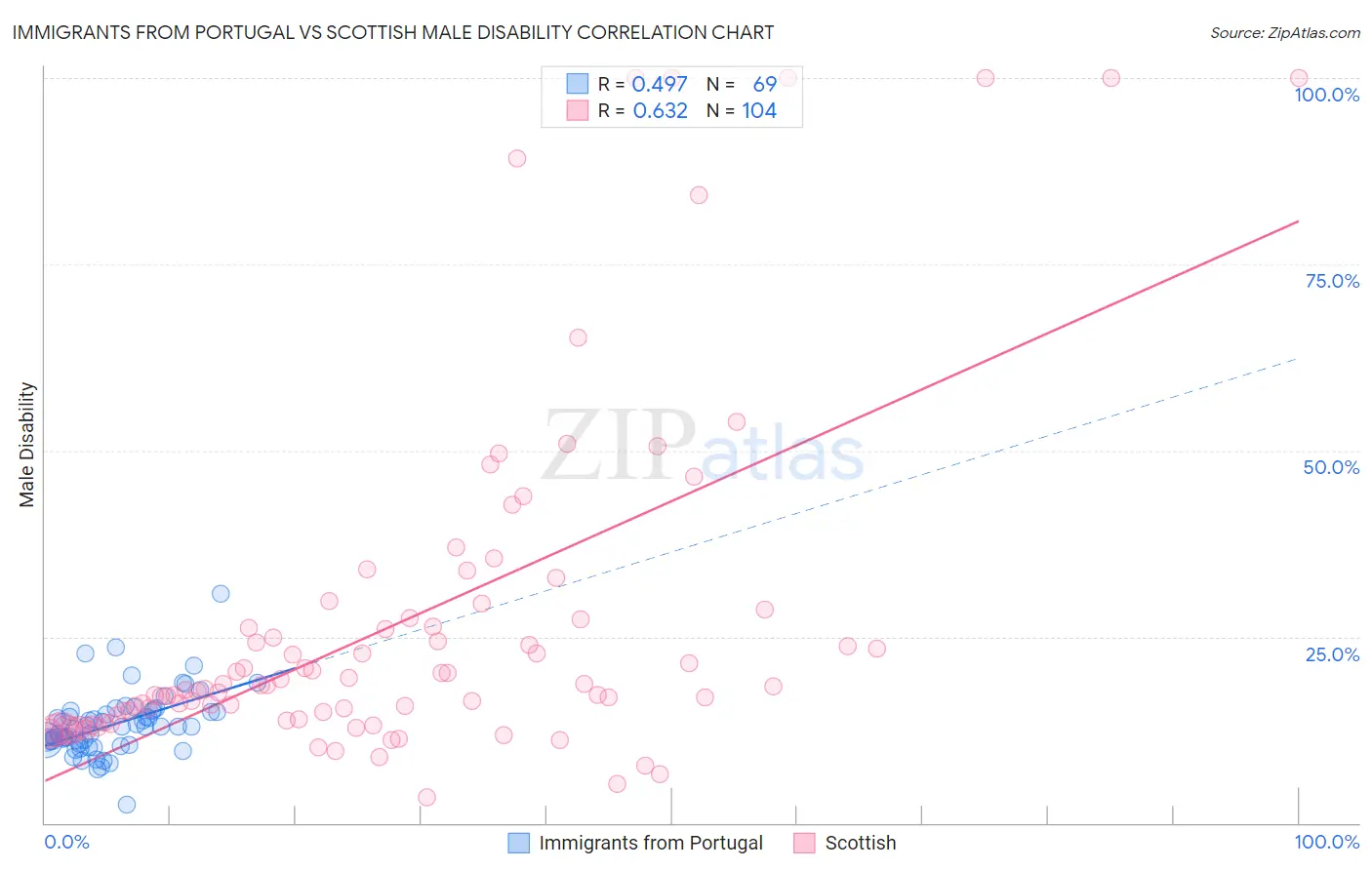Immigrants from Portugal vs Scottish Male Disability
COMPARE
Immigrants from Portugal
Scottish
Male Disability
Male Disability Comparison
Immigrants from Portugal
Scottish
12.3%
MALE DISABILITY
0.1/ 100
METRIC RATING
265th/ 347
METRIC RANK
12.8%
MALE DISABILITY
0.0/ 100
METRIC RATING
286th/ 347
METRIC RANK
Immigrants from Portugal vs Scottish Male Disability Correlation Chart
The statistical analysis conducted on geographies consisting of 174,781,482 people shows a moderate positive correlation between the proportion of Immigrants from Portugal and percentage of males with a disability in the United States with a correlation coefficient (R) of 0.497 and weighted average of 12.3%. Similarly, the statistical analysis conducted on geographies consisting of 566,868,484 people shows a significant positive correlation between the proportion of Scottish and percentage of males with a disability in the United States with a correlation coefficient (R) of 0.632 and weighted average of 12.8%, a difference of 4.0%.

Male Disability Correlation Summary
| Measurement | Immigrants from Portugal | Scottish |
| Minimum | 2.4% | 3.4% |
| Maximum | 30.8% | 100.0% |
| Range | 28.4% | 96.6% |
| Mean | 13.2% | 27.0% |
| Median | 12.9% | 18.4% |
| Interquartile 25% (IQ1) | 11.0% | 14.2% |
| Interquartile 75% (IQ3) | 15.0% | 27.4% |
| Interquartile Range (IQR) | 3.9% | 13.2% |
| Standard Deviation (Sample) | 4.2% | 23.1% |
| Standard Deviation (Population) | 4.2% | 23.0% |
Similar Demographics by Male Disability
Demographics Similar to Immigrants from Portugal by Male Disability
In terms of male disability, the demographic groups most similar to Immigrants from Portugal are Hawaiian (12.3%, a difference of 0.020%), Immigrants from Germany (12.3%, a difference of 0.070%), Portuguese (12.3%, a difference of 0.19%), Czechoslovakian (12.3%, a difference of 0.19%), and Spaniard (12.3%, a difference of 0.28%).
| Demographics | Rating | Rank | Male Disability |
| Basques | 0.3 /100 | #258 | Tragic 12.1% |
| Belgians | 0.3 /100 | #259 | Tragic 12.1% |
| Swedes | 0.3 /100 | #260 | Tragic 12.1% |
| Slavs | 0.2 /100 | #261 | Tragic 12.2% |
| Norwegians | 0.2 /100 | #262 | Tragic 12.2% |
| Canadians | 0.2 /100 | #263 | Tragic 12.2% |
| Nepalese | 0.2 /100 | #264 | Tragic 12.2% |
| Immigrants | Portugal | 0.1 /100 | #265 | Tragic 12.3% |
| Hawaiians | 0.1 /100 | #266 | Tragic 12.3% |
| Immigrants | Germany | 0.1 /100 | #267 | Tragic 12.3% |
| Portuguese | 0.1 /100 | #268 | Tragic 12.3% |
| Czechoslovakians | 0.1 /100 | #269 | Tragic 12.3% |
| Spaniards | 0.1 /100 | #270 | Tragic 12.3% |
| Scandinavians | 0.1 /100 | #271 | Tragic 12.3% |
| Hmong | 0.0 /100 | #272 | Tragic 12.5% |
Demographics Similar to Scottish by Male Disability
In terms of male disability, the demographic groups most similar to Scottish are Welsh (12.7%, a difference of 0.050%), Spanish (12.7%, a difference of 0.060%), Cape Verdean (12.8%, a difference of 0.070%), Yup'ik (12.8%, a difference of 0.26%), and German (12.7%, a difference of 0.32%).
| Demographics | Rating | Rank | Male Disability |
| Slovaks | 0.0 /100 | #279 | Tragic 12.7% |
| Dutch | 0.0 /100 | #280 | Tragic 12.7% |
| Sioux | 0.0 /100 | #281 | Tragic 12.7% |
| Irish | 0.0 /100 | #282 | Tragic 12.7% |
| Germans | 0.0 /100 | #283 | Tragic 12.7% |
| Spanish | 0.0 /100 | #284 | Tragic 12.7% |
| Welsh | 0.0 /100 | #285 | Tragic 12.7% |
| Scottish | 0.0 /100 | #286 | Tragic 12.8% |
| Cape Verdeans | 0.0 /100 | #287 | Tragic 12.8% |
| Yup'ik | 0.0 /100 | #288 | Tragic 12.8% |
| Immigrants | Cabo Verde | 0.0 /100 | #289 | Tragic 12.8% |
| Pima | 0.0 /100 | #290 | Tragic 12.8% |
| Whites/Caucasians | 0.0 /100 | #291 | Tragic 12.8% |
| English | 0.0 /100 | #292 | Tragic 12.8% |
| Yaqui | 0.0 /100 | #293 | Tragic 12.9% |